Population
22. Aug 2023
Population surpasses 54,600

Since the population growth began almost a decade ago, the Faroese population has increased by 6,500 people, or 14%. This growth, which has varied across regions and over the years, has slowed down somewhat recently.
[px-graph-3]
The population trend is determined by net migration, i.e. the difference between the number of immigrants and the number of emigrants, and the excess of live births over deaths. The population growth in the past year comes from an excess of births of 185 people and a net migration figure of 424 people. The table below shows a decrease in net migration and an increase in the excess of births, compared to the previous 12-month period.
Migration figures unchanged
The trends in the graph below indicate little change in the difference between immigration and emigration in recent months. Immigration and emigration started increasing in late 2020, a trend continuing up to autumn 2022. The immigration trend then started declining, while the growth in emigration came to a halt. Migration figures have not changed much since then.
[px-graph-3]
More decline in death rates than in birth rates
The trends indicate that birth rates and death rates have been declining in recent months.
Death rates have, however, declined more than birth rates, resulting in a higher excess of live births over deaths. The death rate has now returned to the level prior to last year’s unusually large increase in death rates.
[px-graph-4]
Highest growth this decade was in Eysturoy
The population has been growing steadily over the past decade, but the numbers have varied greatly across the country. Compared to 1 July 2013, all regions except Sandoy and Suðuroy have seen population growth. The biggest growth was registered in regions Suðurstreymoy and Eysturoy (17-18%), followed by Vága, Norðoya and Norðstreymoyar (7-12%). Sandoy and Suðuroy have seen virtually no change in population figures. The graph below shows the percentage growth since 2013.
[px-graph-5]
Highest growth in the large municipalities
Out of the 29 municipalities, Tórshavn, Runavík and Klaksvík municipalities had the highest population growth in the past year, followed by Nes, Sjóvar and Vestmanna municipalities. The towns or cities with the largest growth were Tórshavn, Klaksvík, Argir, Saltangará and Toftir. The table below shows the population across the 29 municipalities, with details for each town and village on 1 July 2022 and 1 July 2023.
[px-graph-4]
Population figures have a one-month lag
The figures have a one-month lag due to delays in registrations, especially regarding address changes, where many registrations are made after the month of address change has ended. To accommodate as many corrections as possible, there is a one-month lag in the data.
About the population figures
The population is defined as all individuals registered in the national register as residents of the Faroe Islands. Population data includes date of birth, gender, place of birth, citizenship, relationship status, and, where applicable, information on immigration and emigration, domestically as well as between the Faroe Islands and other nations.
About the trend
The trend describes the population trend by adjusting for seasonal effects and other error components in the population figure.